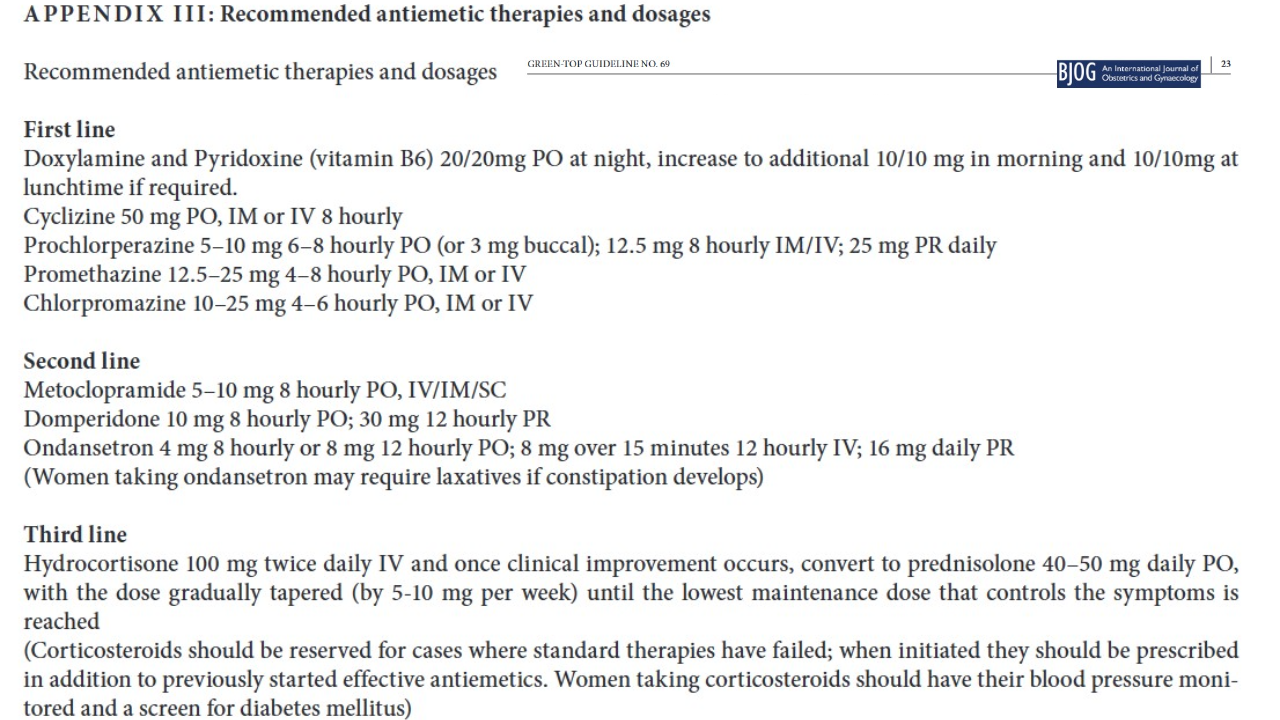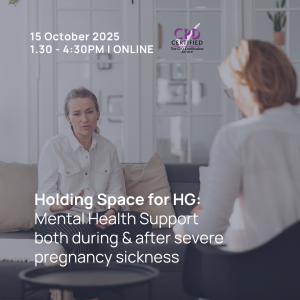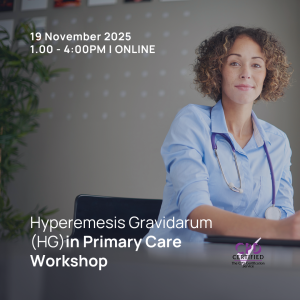GP Support Hub: Diagnosing & managing HG with confidence
Practical, evidence-based tools and guidance for GPs and primary care teams.
This hub offers clear clinical information to help you recognise, diagnose, and treat Hyperemesis Gravidarum (HG) early and effectively, in line with RCOG guidelines.
Twelve important things to recognise, know and put into practice when treating Nausea and Vomiting in Pregnancy (NVP) and Hyperemesis Gravidarum (HG).
Spectrum condition
Pregnancy Sickness is a spectrum condition with 7-9 out of ten pregnancies being affected by it to some degree. It’s not “just morning sickness” and for many ‘morning sickness’ is actually a harmful term and should not be used.
Hyperemesis Gravidaum (HG)
Hyperemesis Gravidarum (HG) is a condition at the severe end of the pregnancy sickness spectrum and will affect up to 30,000 pregnancies a year (approximately 3%). It is very likely a genetic condition and is not linked to HCG levels.
Treatment is vital
Treatment is necessary to manage symptoms of moderate to severe pregnancy sickness and HG, and in cases that are poorly managed, symptoms will worsen increasing the severity and complications can ensue.
Hospital care
Patients may become dehydrated/malnourished as a result of poorly managed HG and often require treatment in hospital. This needs to be timely, and you should know your referral pathways into local services.
Vomiting not required
Not all severe pregnancy sickness and HG look the same, and some women will never/rarely vomit but may experience severe debilitating nausea. Nausea is enough for a diagnosis under the clinical definition.
Sufferers journey to GP care
Usually, by the time women present to their GP, they will have tried several at-home remedies to try and help alleviate symptoms, and have reached the point where things feel unmanageable. Ginger, sea sickness bands and eating little and often should not be recommended.
Doesn't end at 12 weeks
Typically HG symptoms peak during 9-13 weeks gestation, but symptoms can continue throughout the second trimester and 1 in 5 patients will continue to suffer throughout the duration of their pregnancy.
Holistic view of experience required
A holistic view means recognising how HG affects daily life beyond physical symptoms, using validating language, and considering social and cultural factors that may impact her ability to manage the condition.
Ditch the ketone tests
Mental health support should be offered
HG sufferers are 8 x more likely to suffer from ante-natal depression and nearly 7% will have regular suicidal ideations. Patients should be offered a referral for perinatal mental health support.
Risk of VTE needs to be considered
The latest MBRRACE-UK report (2020–2022) into maternal deaths has revealed a serious finding: a third of the women who died from blood clots (VTE) in the first trimester were also suffering from Hyperemesis Gravidarum (HG).
Download our factsheet on VTE and HG here.
Signpost to PSS
As the only UK registered charity supporting women and people with pregnancy sickness and HG, please remember to signpost patients to our services. We provide a national peer support, counselling and support service.
Diagnostic tools to support primary care professionals.
1. The The International Definition of Hyperemesis Gravidarum (The Windsor Definition 2021)
One of the frustrations pre-2021 was the lack of a clinical definition of Hyperemesis. The Windsor definition was developed by clinicians and researchers in Windsor, London, UK to provide guidance and uniformity across diagnosis and research.
What is important to note from the definition is the and/or inclusion for severe nausea and vomiting. It is a misnomer that sufferers have to vomit to receive a diagnosis of HG.
What is the definition of HG?
The International Definition of Hyperemesis Gravidarum (The Windsor Definition 2021) defines HG as ‘a condition that starts early in pregnancy, before a gestational age of 16 weeks, and is characterized by severe nausea and/or vomiting, inability to eat and/or drink normally and strongly limits daily activities”.
2. The PUQE (Pregnancy-Unique Quantification of Emesis) score is a tool used to assess the severity of nausea and vomiting in pregnancy
Please note, this scoring tool is provided as an online version of the tool provided in the RCOG Greentop Guidelines No.69. It is an indicator of physical symptoms, but does not take into account the personal circumstances of your patient. For example, you score less if you haven’t vomited, but nausea is as debilitating and crippling especially if you have other children to care for, work in an office, have to travel for work and vice versa.
Please use this tool to receive a PUQE score as part of a holistic view of your patients symptoms and experience.
Total score indicating severity of symptoms is the sum of replies to each of the three questions: mild <= 6; moderate 7–12; severe 13–15.
Source: [Nelson-Piercy, 2024a]
3. The RCOG Greentop Guidelines on Nausea & Vomiting in Pregnancy & Hyperemesis Gravidarum (HG) No.69 2024 and The HyperEmesis Level Prediction (HELP) Score Assessment
GP RCOG Appendix
The guideline provides updated evidence-based or best clinical practice information regarding the diagnosis and subsequent management of nausea and vomiting in pregnancy (NVP) and hyperemesis gravidarum (HG) across community, ambulatory day care and inpatient settings.
The appendix for primary care can be downloaded below. This includes initial assessment, diagnosis and severity assessment, management and antiemetic therapy and clear guidance on how to treat patients with pregnancy sickness or HG.
The HELP Score
The HyperEmesis Level Prediction (HELP) score is a validated scoring tool developed by the HER Foundation in the USA.
It can be used to determine whether HG symptoms are mild, moderate, or severe. Scores reflect the severity of hyperemesis gravidarum, or severe nausea and vomiting during pregnancy (pregnancy sickness).
The HELP score is not included in the RCOG Greentop Guidelines as a diagnostic tool but is used regularly in the UK to widen the holistic view of diagnosing.
Antiemetic treatments:
A quick guide
From the RCOG Greentop Guidelines No. 69 on Nausea & Vomiting in Pregnancy (NVP) & Hyperemesis Gravidarum (HG) 2024.

PSS provide CPD accredited training for healtcare professionals *live* (online) and via our on-demand training hub. You can access our on-demand training soon – but in the meantime here are a selection of our upcoming *live* training.
RCGP's Screencast resource
Hyperemesis gravidarum represents the most severe end of the spectrum of pregnancy related nausea and vomiting. Complications can include renal failure, venous thromboembolism, suicidal ideation and termination of a wanted pregnancy. This screencast discusses the diagnostic criteria, which are based on symptoms rather than signs of dehydration. The PUQE score is explained, which can be used to support a diagnosis, and the evidence base behind the safety of antiemetics in the first trimester is reviewed.
An educational grant was received from Pregnancy Sickness Support for the production of this screencast. Editorial and content decisions were made solely by the RCGP.
The Hyperemesis gravidarum screencast is free to access for any healthcare professional with an RCGP account (the login details used to access ‘My RCGP’ on the main RCGP website can also be used for the eLearning site). A free account can be created by going to the following link and scrolling down to the ‘Non-membership access’ section:
Would you like to register as a HG friendly professional?
We invite Healthcare Professionals, Counsellors, Therapists and other professionals who support women and pregnant people with Hyperemesis Gravidarum (HG) and Nausea & Vomiting in Pregnancy (NVP) to apply to be on our HG Friendly List, so we can signpost sufferers to services and professional help, where the charity is unable to provide support.



